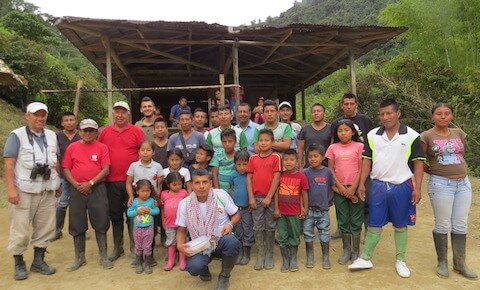Main menu
CEPF is a joint initiative of l’Agence Française de Développement, Conservation International, the European Union, Fondation Hans Wilsdorf, the Global Environment Facility, the Government of Japan and the World Bank.
Visitez le site français コア情報の日本語翻訳を読むOr use Google Translate to translate the English site to your language:
GTranslate
Indigenous Peoples and Biodiversity: A Symbiotic Relationship
In celebration of International Day of the World’s Indigenous Peoples, we highlight three CEPF grantees.
09 August 2018
09 August 2018
Biodiversity and the wellbeing of indigenous communities are strongly interlinked.
“Indigenous peoples are of paramount importance to biodiversity because they are the custodians of very large natural areas, and very often that land is pristine,” said CEPF Executive Director Olivier Langrand.
Biodiversity, meanwhile, provides indigenous people with shelter, food and medicine, and is an important part of their cultural identity. Studies have even shown a positive correlation between the diversity of ecosystems and the number of native languages in the area.
The ecosystems contained in the biodiversity hotspots—where CEPF works—are, by definition, fragmented: To qualify as a hotspot, a region must not only contain at least 1,500 species of vascular plants found nowhere else, but also have lost at least 70 percent of its original surface cover. This makes the indigenous people who live in a hotspot particularly vulnerable to any further degradation. Climate change comes on top of habitat destruction and fragmentation, especially for island-based communities who face the impacts of severe weather events must contend with rising water levels and who may, ultimately, be displaced.
CEPF strives to support nascent organizations, including indigenous groups, many of which receive their first-ever grants from CEPF. Since inception, at least 130 CEPF-funded projects totaling more than US$13 million have assisted indigenous peoples. Often this involves helping them gain formal land tenure and rights to manage their ancestral lands.
“Our objective is not only to reach out to local groups and provide them with funds, but to support them in designing and implementing their projects,” said Nina Marshall, senior director of monitoring, evaluation and outreach. “Through our regional implementation teams, we’re able to work with organizations to build their capacity and help them achieve their conservation goals.”
In addition, CEPF applies safeguards that ensure every CEPF project considers and consults with indigenous stakeholders. “Safeguards ensure that no harm will come to local people through the project and that they are fully aware and consulted beforehand,” Marshall said.
In honor of International Day of the World’s Indigenous Peoples, we’re highlighting three CEPF grantees from indigenous communities.
Strengthening Leadership
In southwestern Colombia, the InkalAwa people were given the right to manage their ancestral land— Pialapí Pueblo Viejo Indigenous Reserve—in 2010.
Local indigenous organization Resguardo Pialapí Pueblo Viejo (RPPV) is working to develop a management plan for the reserve while increasing its own capacity.
CEPF-funded training has enhanced the RPPV’s administrative capacity and enhanced its budgetary and accounting processes.
“The indigenous people had no experience in the management of a natural reserve,” said Miguel Caicedo, RPPV’s director. “This project has shown them how to administer and create a plan for the reserve, so they can develop other projects and acquire the funding they need for implementation.”
Perhaps the most important outcome for the project, though, is the way it has affected how the InkalAwa people view the land.
“For most of their lives, the indigenous people have seen the reserve as something not part of their own lives or territory,” Caicedo said. “Being involved in the development of this plan has been an important step toward empowering them to manage the reserve.”
Mobilization of Indigenous Communities
In Cambodia, CEPF funding helped Highlanders Association work with seven indigenous peoples associations to provide training in leadership, organizational management, governance and transparency.
This training assisted these marginalized groups in exercising their rights to protect their forest and land. The project merged the seven associations into the Ratanakiri Indigenous Peoples Alliance and, through this partnership, the group has been able to make their voices heard, not just locally, but in the international arena on issues affecting their culture, traditions and environment.
Through these efforts, multiple collaborative actions have taken place, including the adoption of collective farming and saving groups. Members have also received trainings on the impacts that agriculture and mining companies have on access to land and resources.
Carbon Credits for Conservation
The Kenya-based Maasai Wilderness Conservation Trust (MWCT) has been working for years to protect Chyulu Hills, home to iconic African wildlife—elephants, giraffes and lions among them—and the indigenous Maasai people.
Part of these efforts have included establishing a REDD+ project. (REDD+ stands for “reduced emissions from deforestation and forest degradation, plus the role of conservation, sustainable management of forests and the enhancement of forest carbon stocks.”)
The REDD+ project is designed to pay the residents of the area for maintaining the forest. Payments to the community come from the sale of carbon credits on the international voluntary market.
To bring the project, which was more than six years in the making, to fruition, MWCT needed to verify the carbon credits generated by the forest by completing the necessary greenhouse gas emissions reduction quantification, verification, and social and biological monitoring. A CEPF grant helped cover the cost of verification and enabled the project’s first carbon credit sale. In September 2017, the sale of 19,800 credits was made to Tiffany and Co., providing US$237,600 of revenue for the community.
This revenue has helped support additional conservation activities along with education and health care needs.
"Community members and leaders have been delighted to see the first funds being made available and to be able to direct those funds towards supporting their priorities,” said Samson Parashina, community leader and chairman of MWCT. “The carbon sales help to demonstrate that conservation can contribute to community well-being and the local economy.”






